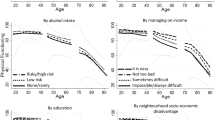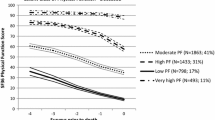Abstract
Background and aims: Marital and parental role characteristics are important factors in both men and women’s health. Most studies to date have either focused on disease specific outcomes or summary measures of self-reported health rather than using functional tests of performance. The goal of this study is to investigate the extent to which marital and parental role characteristics are associated with midlife physical function. Methods: A prospective birth cohort study was carried out with reference to births that took place in England, Scotland, and Wales during one week in March of 1946. Regular assessment of 1353 men and 1411 women were made from six weeks after birth throughout childhood and adulthood. Handgrip strength, timed chair rising, and standing balance tests at age 53 years were used to calculate an aggregate physical performance score that ranged from 0 (poorest score) to 2.81. Results: The mean physical performance score was 1.42 (SD 0.42) for men and 1.30 (SD 0.37) for women. By age 53 years, 11% of men and 8% of women had married but remained childless; 6% of men and 4% of women had never married. Never married (x 1.15; 95% CI 1.06, 1.24) and childless married men ($⋏r x$ 1.36; 95% CI 1.30, 1.42) had significantly poorer physical performance scores than married men with children ($⋏r x$ 1.46; 95% CI 1.43, 1.48). These relationships remained after adjustment for adult social class and employment status, own educational attainment and body mass index at 53 years (beta=−0.18, 95% CI −0.27, −0.09 for never married and beta=−0.09, 95% CI −0.16, −0.03 for childless married, compared with married men with children). Of those men who had never married, 28% reported they were not working due to long-term health problems compared to 5% in both childless married men and married men with children. There were no marked differences in functional outcomes among women. Conclusions: In this representative middle-aged population, unmarried and childless men faced greater risk of poor midlife physical function, even after adjustment for confounders. These findings suggest that for men, marriage and parenthood protect against functional decline in midlife. Alternatively, physical performance may be a marker of poorer health in earlier life, which affects the chance of marriage and parenthood.
Similar content being viewed by others
Reference
Manzoli L, Villlari P, Pirone G, Boccia A. Marital status and mortality in the elderly: A systematic review and meta-analysis. Soc Sci Med 2007; 64: 77–94.
Johnson N, Backlund E, Sorlie P, Loveless C. Marital status and mortality: The national longitudinal mortality study. Ann Epidemiol 2000; 10: 224–38.
Kaplan R, Kronick R. Marital status and longevity in the United States population. J Epidemiol Community Health 2006; 60: 760–5.
Ebrahim S, Wannamethee G, McCallum A, Walker M, Shaper A. Marital status, change in marital status, and mortality in middle-aged British men. Am J Epidemiol 1995; 142: 834–42.
Mastekaasa A. Parenthood, gender and sickness absence. Soc Sci Med 2000; 50: 1827–42.
Kotler P, Wingard DL. The effect of occupational, marital and parental roles on mortality: the Alameda County Study. Am J Public Health 1989; 79: 607–12.
Martikainen P. Women’s employment, marriage, motherhood and mortality: a test of the multiple role and role accumulation hypotheses. Soc Sci Med 1995; 40: 199–212.
Benzeval M. The self-reported health status of lone parents. Soc Sci Med 1998; 46: 1337–53.
Weitoft GR, Haglund B, Hjern A, Rosen M. Mortality, severe morbidity and injury among long-term lone mothers in Sweden. Int J Epidemiol 2002; 31: 573–80.
Weitoft G, Burstrom B, Rosen M. Premature mortality among lone father and childless men. Soc Sci Med 2004; 59: 1449–59.
Bennett K. Does marital status and marital status change predict physical health in older adults? Psychol Med 2006; 36: 1313–20.
Guralnik JM, Ferrucci L. Assessing the building blocks of function: Utilizing measures of functional limitation. Am J Prev Med 2003; 25: 112–21.
Wadsworth M, Kuh D, Richards M, Hardy R. Cohort profile: The 1946 National Birth Cohort (MRC National Survey of Health and Development). Int J Epidemiol 2006; 35: 49–54.
Wadsworth ME, Butterworth SL, Hardy RJ et al. The life course prospective design: an example of benefits and problems associated with study longevity. Soc Sci Med 2003; 57: 2193–205.
Kuh D, Bassey EJ, Butterworth S, Hardy R, Wadsworth M. Grip strength, postural control, and functional leg power in a representative cohort of British men and women; associations with physical activity, health status, and socioeconomic conditions. J Gerontol Med Sci 2005; 60: 224–31.
Bassey EJ, Harries UJ. Normal values for handgrip strength in 920 men and women aged over 65 years, and longitudinal changes over 4 years in 620 survivors. Clin Sci 1993; 84: 331–7.
Kronhed G, Moller C, Olsson B. The effect of short-term balance training on community-dwelling older adults. J Aging Phys Activity 2001; 9: 19–31.
Guralnik JM, Butterworth S, Wadsworth ME, Kuh D. Childhood socioeconomic status predicts physical functioning a half century later. J Gerontol Med Sci 2006; 61: 694–701.
Guralnik JM, Fried LP, Salive ME. Disability as a public health outcome in the aging population. Ann Rev Public Health 1996; 17: 25–46.
Leveille SG, Penninx BW, Melzer D, Izmirlian G, Guralnik JM. Sex differences in the prevalence of mobility disability in old age: the dynamics of incidence, recovery, and mortality. J Gerontol Soc Sci 2000; 55: 41–50.
Kiernan K. Who remains celibate? J Biosoc Sci 1988; 20: 253–63.
McMunn A, Bartley M, Kuh D. Women’s health in mid-life: life course social roles and agency as quality. Soc Sci Med 2006; 63: 1561–72.
Willits M, Benzeval M, Stansfield S. Partnership history and mental health over time. J Epidemiol Community Health 2004; 58: 53–8.
Janlert U, Asplund K, Weinehall L, Orth-Gomer K, Unden A. Men who never married. A socio-medical study in northern Sweden. Arctic Med Res 1992; 51: 72–80.
Pudrovska T, Schieman S, Carr D. Strains of singlehood in later life: Do race and gender matter? J Gerontol Soc Sci 2006; 61: 315–22.
Hoeffer B. Predictors of life outlook of older single women. Res Nurs Health 1987; 10: 111–7.
Cwikel J, Gramotnev H, Lee C. Never-married childless women in Australia: health and social circumstances in older age. Soc Sci Med 2006; 62: 1991–2001.
Barrett AE, Lynch SM. Caregiving networks of elderly persons: variation by marital status. Gerontologist 1999; 39: 695–704.
Government Actuary’s Department, Marital Status Projections for England and Wales, http://www.gad.gov.uk/marital_status_projections/2003/index_principal.htm, accessed July 13, 2007.
Rantanen T, Guralnik JM, Foley D, et al. Midlife hand grip strength as a predictor of old age disability. JAMA 1999; 281: 558–60.
Guralnik JM, Ferrucci L, Simonsick EM, Salive ME, Wallace RB. Lower extremity function in persons over the age of 70 years as a predictor of subsequent disability. N Engl J Med 1995; 332: 556–61.
Author information
Authors and Affiliations
Corresponding author
Rights and permissions
About this article
Cite this article
Guralnik, J.M., Butterworth, S., Patel, K. et al. Reduced midlife physical functioning among never married and childless men: evidence from the 1946 British Birth Cohort Study. Aging Clin Exp Res 21, 174–181 (2009). https://doi.org/10.1007/BF03325226
Received:
Accepted:
Published:
Issue Date:
DOI: https://doi.org/10.1007/BF03325226




